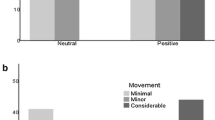Abstract
During play with a dog, humans commonly command the dog to engage in particular activities. How effective are commands during play, and do they serve as play signals? To answer this question, I examined commands issued to dogs by 21 familiar and 17 unfamiliar persons who played with a dog, and the dog’s responses. Specifically, I examined dogs’ actions following commands containing the words (in decreasing order of frequency) come/come here, go get/get/go, give/gimme, bring, look, and drop, to see if they satisfied the commands and whether play followed the commands. Dogs more often ignored than satisfied most commands during play interactions, and more often played than not following commands. However, dogs playing after commands as often satisfied as ignored a command, suggesting that commands do not serve as play signals. Play activity dogs were engaged in following commands, most commonly object-keepaway and chase the object, resulted in actions (e.g., getting closer or farther away from the play partner) that could either satisfy or not satisfy a given command. Commands were likely a response to dogs’ activities, spoken to direct a dog to engage in a particular activity or exhort the dog to continue engaging in an activity that supported the human’s play activities, rather than a play signal.
Similar content being viewed by others
References
Bekoff M (1974) Social play and play-soliciting by infant canids. Amer Zool 14:323–340
Byosiere S-E, Espinosa J, Marshall-Pescini S, Smuts B, Range F (2016) Investigating the function of play bows in dog and wolf puppies (Canis lupus familiaris, Canis lupus occidentalis). PLoSOne 11(12):e0168570
D’Aniello B, Scandurra A, Alterisio A, Valsecchi P, Prato-Previde E (2017) The importance of gestural communication: a study of dog-human communication using incongruent information. Anim Cogn 20:777–787
Elgier AM, Jakovcevic A, Mustaca AE, Bentosela M (2009) Learning and owner-stranger effects on interspecific communication in domestic dogs (Canis familiaris). Behav Proc 81:44–49
Fukuzawa M, Mills DS, Cooper JJ (2005) More than just a word: non-semantic command variables affect obedience in the domestic dog (Canis familiaris). Appl Anim Behav Sci 91:129–141
Goode D (2007) Playing with My Dog Katie: An Ethnomethodological Study of Dog-Human Interaction. Purdue University Press, West Lafayette, Indiana
Horowitz AC, Hecht J (2016) Examining dog-human play: the characteristics, affect, and vocalizations of a unique interspecific interaction. Anim Cogn 19:779–788
Kerepesi A, Dóka A, Miklósi Á (2015) Dogs and their human companions: the effect of familiarity on dog-human interactions. Behav Proc 110:27–36
Mitchell RW (2001) Americans’ talk to dogs during play: similarities and differences with talk to infants. Res Lang Soc Interact 34:182–210
Mitchell RW (2004) Controlling the dog, pretending to have a conversation, or just being friendly? influences of sex and familiarity on Americans’ talk to dogs during play. Interact Stud 5:99–129
Mitchell RW (2017) A critique and empirical assessment of Alexandra Horowitz and Julie Hecht’s “Examining dog-human play: the characteristics, affect, and vocalizations of a unique interspecific interaction.” Anim Cogn 20:554–565
Mitchell RW, Edmonson E (1999) Functions of repetitive talk to dogs during play. Soc Anim 7:55–81
Mitchell RW, Thompson NS (1991) Projects, routines, and enticements in dog-human play. In: Bateson PPG, Klopfer PH (eds) Perspectives in ethology, vol 9. Plenum Press, New York, pp 189–216
Palagi E, Burghardt GM, Smuts B, Cordoni G, Dall’Olio S, Fouts HN, Reháková-Petrů M, Siviy SM, Pellis SM (2016) Rough-and-tumble play as a window on animal communication. Biol Rev 91:311–327
Pongrácz P, Miklósi Á, Csányi V (2001) Owner’s beliefs on the ability of their pet dogs to understand human verbal communication: a case of social understanding. Cahiers de Psychol Cogn/Curr Psych Cogn 20(1–2):87–107
Rooney NJ, Bradshaw JWS, Robinson H (2001) Do dogs respond to play signals given by humans? Anim Behav 61:715–722
Scandurra A, Altrisio A, Marinelli L, Mognill P, Semin GR, D’Aneillo B (2017) Effectiveness of verbal and gestural signals and familiarity with signal-senders on the performance of working dogs. Appl Anim Behav Sci 191:78–83
Schwab C, Huber L (2006) Obey or not obey? Dogs (Canis familiaris) behave differently in response to attentional states of their owners. J Comp Psych 120(3):169–175
Wright KR, Mayhew JA, Sheeran LK, Funkhouser JA, Wagner RS, Sun L-X, Li J-H (2018) Playing it cool: characterizing social play, bout termination, and candidate play signals of juvenile and infant Tibetan macaques (Macaca thibetana). Zool Res 39(4):272–283
Yanagi A, Berman CM (2014) Body signals during social play in free-ranging rhesus macaques (Macaca mulatta): a systematic analysis. Amer J Primat 76(2):168–179
Acknowledgements
I greatly appreciate the assistance of Molly King, Shelby Strong, Brian Keller, Kelcie Brophy, Michelle Smith, Lisa Kay, the reviewers and editors, and the players in this study.
Funding
This study received no funding.
Author information
Authors and Affiliations
Corresponding author
Ethics declarations
Ethical approval
All applicable international, national, and/or institutional guidelines for the care and use of animals were followed. All procedures performed in studies involving human participants were in accordance with the ethical standards of the institutional and/or national research committee and with the 1964 Helsinki declaration and its later amendments or comparable ethical standards.
Informed consent
Informed consent was obtained from all individual participants included in the study.
Additional information
Publisher's Note
Springer Nature remains neutral with regard to jurisdictional claims in published maps and institutional affiliations.
Rights and permissions
About this article
Cite this article
Mitchell, R.W. You talkin’ to me? An assessment of commands as play signals during dog–human play. Anim Cogn 24, 329–339 (2021). https://doi.org/10.1007/s10071-021-01469-5
Received:
Revised:
Accepted:
Published:
Issue Date:
DOI: https://doi.org/10.1007/s10071-021-01469-5




